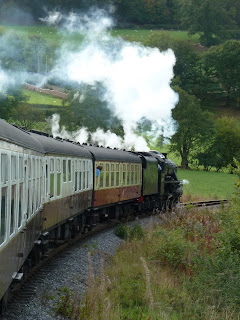Llangollen is another iconic place I’ve always wanted to visit. It’s a small, picturesque village in Northern Wales, located just a few miles from the English border. My initial interest was provoked by images of the stunning Pontcysyllte Aqueduct built a few miles from town. This impressive structure is a slender cast-iron tough that carries the Llangollen Canal across the Dee River valley. The aqueduct is 316 metres long, rising almost 39 metres above the surrounding valley.
It was built by the great civil engineer, Thomas Telford, in 1805. Telford was also responsible for the construction of the Llangollen canal, built to feed water from the River Dee to the Shropshire Union Canal. If that wasn’t enough, Telford also modernised the ancient road from London to Holyhead in Northeast Wales that passes through Llangollen, known today as the A5 highway.
For many reasons, Garry and I never quite made it to Llangollen while we were living in the UK. As a result, since returning to Australia I’ve made it a personal ambition to actually get there. Last weekend, this goal was finally achieved when I rented a car and drove north while in London for business. I’m glad I made the effort. Llangollen turned out to be one of the prettiest, most memorable locations I’ve ever visited in the UK. Much of the original village has been carefully preserved, sitting on the banks of a truly picturesque river, each half linked by an equally impressive stone arch bridge.
Aside from the Pontcysyllte Aqueduct, Llangollen is also famous for its lovingly restored steam railway that runs through the Dee Valley. The original rail track arrived in the town in 1862 and operated until 1968. Since its closure, more than seven miles of track between Llangollen and the nearby village of Carrog have been carefully restored by a volunteer society of rail enthusiasts. The society runs steam train rides several times. On Sunday I caught the first train of the day to Carrog and back.
It was a wonderful adventure. A large crowd gathered on the restored Victorian rail platform to watch the train pull up in a cloud of steam and smoke. Once the engine was coupled to a set of restored carriages we slowly departed to the rhythmic sounds of a chugging engine and clattering wheels. The river valley was picture-perfect. Sheep scattered as we passed and I felt a sense of history in my hair as I hung out of the window watching the train round each bend.
Upon returning to Llangollen I wandered along the town’s riverwalk and through its narrow, winding streets. Mid-afternoon I joined a tour that drove a small group of us to the Pontcysyllte Aqueduct where we boarded a canal boat, crossed the aqueduct, and then along the Llangollen canal back to town. The tour took roughly two hours, passing through yet more postcard-perfect scenery. The view is made all the more memorable by the canal’s unusual location, sitting high up on the side of the valley.
If that wasn’t enough, even my hotel room delivered an unexpected treat. I stayed at the Hand Hotel. Originally a 17th-century coaching inn, the building backs onto the grounds of the Church of St Collen. Collen is a popular Welsh saint who is reputed retired to Llangollen after murdering a local man-eating giantess.
My hotel room was on the hotel's second floor. Much to my delight, it came with a classic view of the stone church and its immaculate grounds. The current stone building was begun in the 13th Century, but later remodeled in 1864-67. I later learned that Llangollen’s name is actually derived from this church. In Welsh, Llan means enclosure, and thus the town’s name literally translates as Collen’s enclosure.
Even better, over breakfast, my table offered a scenic view across the Dee River valley to an isolated hill overlooking the town. On the hill’s crest the ruins of Castell Dinas Bram, a castle built in 1260, are clearly visible. I’d encourage anyone to visit Llangollen if they get the chance. You won’t be disappointed.
























No comments:
Post a Comment